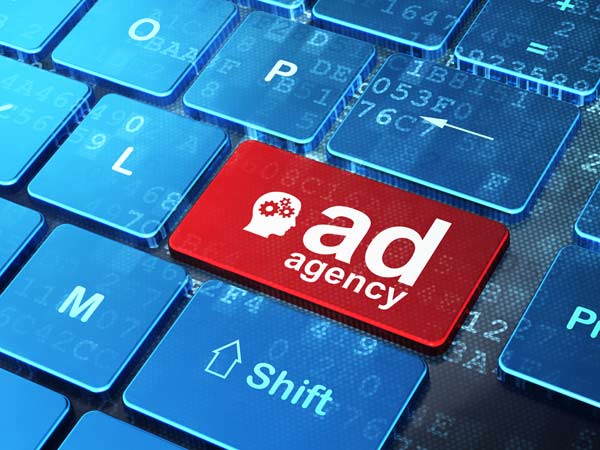Non-traditional advertising goes beyond simply getting a name out there. Goals such as fostering engagement and creating brand advocates take time and cannot be forced.
Companies aren’t the only ones trying to navigate non-traditional advertising methods. Agencies must adapt to stay ahead of the advertising shift as well as master it. That’s precisely why companies are turning to agencies to help them.
Rock Content has compiled these tips and resources to help your company choose an advertising agency that fits best with your business’s goals and vision.
Why is the move away from traditional advertising significant? It’s an opportunity for agencies and marketing using real-time content engagement. Media analyst Gordon Borrell said the little noticed fundamental shift in advertising occurred in 2007.
That’s when, for the first time, local businesses started spending more on “non-advertising marketing activities” than they did on traditional advertising, according to Borrell’s post on the American Advertising Agencies of America blog. There has been 4 percent average annual growth in marketing expenditures since 2007, but none of it has gone to traditional advertising, according to Borrell’s blog post.
Advertisers worldwide are forecast to spend $592.43 billion in 2015, up 6.0 percent from 2014, according to eMarketer. Marketers will spend $189.06 billion on ads in the U.S. alone, which makes up 31.9 percent of the global ad market.
However, those figures might be too optimistic. Three top ad companies downsized their 2015 forecast for global ad spending due to weaker markets in Eastern Europe and the core Eurozone and slower than expected U.S. ad revenues, The Wall Street Journal reported in early December.
The advertising shift and rapidly changing digital space are keeping CMOs busy. A Korn Ferry survey asked 215 marketing executives what kept them up at night. A top concern among 27 percent of CMO respondents was staying ahead of and taking advantage of digital technology trends.
The constant pace of change and CMOs’ pressure to follow the latest digital trends represent an opportunity for agencies.
“Agencies are needed more than ever in an increasingly fragmented world,” JPMorgan analyst Alexia Quadrani told The Wall Street Journal. “There’s a heightened interest in ad agencies as an investment because of the fact they’re media agnostic.”
The ability to work across platforms for brands is just one attractive feature. How well does the agency adapt to change or fit with your company’s overall vision? Those some of the criteria that need to be evaluated in the assessment process. But first, decide when and if you need an agency at all.
“The need for an agency will vary depending on an organization’s brand portfolio, overarching marketing strategies, company-wide objectives, and internal resources,” Kathleen Jordan, Senior Project Manager at Source One Management Services LLC told Engage Magazine.
1. Outline the details of the project or services your company seeks. Draw up specifics that will help frame the type of agency your company seeks, whether it’s for a single project or an ongoing partnership.
“Before engaging any agency candidates, a company must first outline and agree upon the scope of work for the overall assignment. This will drive the best results for an agency search. The key deliverables, strategic goals, and selection criteria will serve as the framework for the entire search process; therefore, establishing this upfront will allow a brand team to clearly understand the type of agency they are looking for, assessing the core competencies, capabilities, and experience levels that need to be delivered to the brand,” Jordan said.
Once the framework is created. Apply that criteria and scope of work to the search. The company’s advertising or marketing needs will largely determine the type of agency search required: Agency of Record Search, Roster Agency Search, Specialty Agency Search, International Agency Search, Ad-hoc Search, Tactical Agency Search and Project Reviews. See the American Association of Advertising Agencies’ definition of each type.
2. Decide the criteria to use for the Agency of Record or one-off project evaluation process. Is your company looking for some project work or a strategic partnership?
“Regardless of the services being delivered and the length of the assignment, the selection criteria for any agency selection process will likely remain the same. The major difference between an [agency of record] evaluation and a one-time project engagement evaluation is the weights assigned to each criterion,” Jordan said.
For example, Jordan pointed out, when evaluating agency candidates for a one-time project, more emphasis may be placed on technical expertise rather than cultural fit; however, both criteria should still be evaluated. On the other hand, when choosing an agency of record, technical expertise may have a lower weight than cultural fit, she added.
Jordan recommends these 10 qualitative criteria for the agency selection process:
Talent and functional expertise
– Account management
– Industry/category expertise
– Executional excellence
– Strategic thinking
– Creativity
– Innovative and/or technologically advanced
– Cultural fit
– Adaptable to change*
– Demonstrated commitment to working with other agency partners*
*Jordan says these two items may not be entirely applicable for one-time project agency candidates, depending on the project length and level of involvement from the brand team.
3. Examine agencies’ range of services and core competencies. How nimble is the agency? The ad landscape is changing, so agencies must also adapt. The WSJ reported agencies are investing in broadening their capabilities. Agencies are being asked to engage with customers in new ways (other than non-traditional advertising) and create all sorts of new types of content, according to The WSJ. If CMOs are concerned with and working to staying current with trends, your agency should be too.
4. Gauge the agency for the right vision and cultural fit. Matching approach and workflow types is critical to the project management process. As part of agency evaluation, find out how they handle project deadlines and project overruns as well as what resources and steps they will take to finish the project when it’s over deadline and/or budget.
“The brand-agency relationship is a key factor that will determine the success of a campaign. If both parties do not share the same vision, it will be challenging to work together and agree upon creative concepts, overall messaging, tactical programs, etc.,” Jordan said.
One such opportunity to assess cultural fit is an initial on-site presentation. She said this helps determine whether the agency is a good fit with the brand team. But she added that if initial on-site presentations do not fit well within the agency search process, then to incorporate certain language into the RFP can ensure that the agency’s core team will be evaluated during the final pitch presentation.
“For these types of presentations, marketing professionals should ask agencies to present on their experience as it relates to the target market for the brand, while also addressing the agency’s core competencies and ability to fulfill the scope of work,” she said.
Jordan recommends requesting case studies that share similarities to the brand for an apples-to-apples comparison.
5. Research ad campaigns and results of those campaigns. Seek examples of agency work to help illustrate the types of examples you’re going for. It might be helpful to find examples that are similar to the type of campaigns you want to launch or ones that your company likes. Examine the results of those campaigns, if available. It might be helpful to find out what the agency behind the campaign or look for an agency that specializes in the type of ads you want to produce that are specific to your industry. For instance, does the agency specialize in social, digital or mobile? This research will help the agencies you’re considering see what you’re interested in.
BusinessWeek’s report “How to Hire an Ad Agency” warns against asking for speculative work for these reasons: top agencies are in high demand, they don’t need to do spec work; spec work is not a true reflection of an agency’s capabilities; the more an agency wants to jump through the hoops with spec work, the more it raises suspicions.
6. Find agencies that have worked in your company’s industry or area of expertise. The learning curve for an agency won’t likely be as great because they will already have a familiarity and understanding of your industry from working with other companies in the same line of work, according to Jordan’s post on the American Marketing Association website. Request examples of case studies for those companies and ask what metrics were used to measure success.
7. Prepare to interview agency candidates. There are several methods for selecting an agency. The AAAA recommends a Request for Information phase from several agencies to introduce themselves. RFI is process of collecting information using a standard set of questions such as agency size, which allows agencies to put forth their unique capabilities, according to the AAAA. This helps gather a preliminary set of candidates — of typically 6-8, but usually no more than 10-15.
When should you skip the RFI and go to using an RFP process? The AAAA says if your company already knows the agency well enough, if there’s a time crunch and if you’re already clear about the agency in which you’d like to engage. Jordan said if it’s a one-time project with a $10,000 budget, it might be best to bypass the RFP process and proceed with a Request for Quotation instead.
Jordan said that since no two brands are the same, the types of questions asked during an agency search will depend on the scope of work and overall objectives of a brand team.
“Marketers should focus their questions on key components of the campaign to make sure that the agency has the experience and capabilities to successfully handle the assignment,” she said.
Jordan’s recommends requesting these details during the RFI:
– Age and history of the agency
– Locations/offices
– Company size including number of full-time equivalents
– Percentage of FTEs by major department
– Range of services
– Core competancies and partnerships that exist to deliver other competancies
– Key accounts gained in the most recent 12 months
– Level of experience in a particular industry/sector
– Case studies
– Account management structure
– Organizational chart
– Potential conflicts of interest
8. Start the process of choosing an agency. After vetting some preliminary candidates using the RFI, now the more intensive process of narrowing down the group takes place with the Request for Proposal phase.
Once there are some semi-finalists, the RFP process is one way to vigorously screen them with a document of requirements. The process is used for media planning and buying, so media planners can negotiate the best rates for their clients, according to MarketingLand. The RFP phase should include the group of semi-finalist agencies and helps assess the cultural fit, according to the AAAA.
“An RFP outlines overall expectations that the selected agency needs to meet, the scope of work, key milestones in the selection process, and evaluation criteria. The RFP also clearly requests information from the agency candidates that will be reviewed in detail by the brand team during the decision making process,” Jordan said.
Jordan recommended requesting an overview of the dedicated account managing function for the RFP assignment, along with a detailed staffing plan indicating the percentage of time each team member will be committing to the assignment. This will help narrow down who should attend the on-site pitch presentation. So those whose time will be devoted to 50 percent or more to the assignment, should be both delivering the pitch and meeting with the brand team in person, according to Jordan.
AAAA recommends paring down the list to two to three finalist and having an in-person meeting and giving the candidate an assignment such as a hypothetical challenge or other spec work.
9. Evaluate agency regularly once relationship begins. When an agency is chosen, that’s the first step in the next process. “Once a final decision is made and the agency is onboarded, a new process begins. The role of your agency partner will evolve and performance evaluations should be held regularly to ensure service levels are being met and the relationship is in good standing,” Jordan said.
There are three main objectives that marketing professionals should keep in mind as they managing their agency relationships, according to Jordan:
They should always be seeking to:
– Enhance the relationship.
– Confirm they have competitive pricing structures in place.
– Be able to properly track agency performance against brand objectives.
“Altogether, establishing an agency relationship program is the best starting point to open communications between marketing professionals and the agencies that support them to reduce risk, ensure top-level performance, proactively address issues, and unlock additional innovative opportunities,” she said.
2024 State of Marketing Report
Your golden ticket to crush your goals with data-driven insights!
2024 State of Marketing Report
Your golden ticket to crush your goals with data-driven insights!

![[Rock NA] State of Marketing Reports 2024 – Comkt Hubspot State of Marketing Report 2024](https://rockcontent.com/wp-content/uploads/2022/07/Banner-Fino-Rock-Convert-2500-%C3%97-500-px-19.png)






